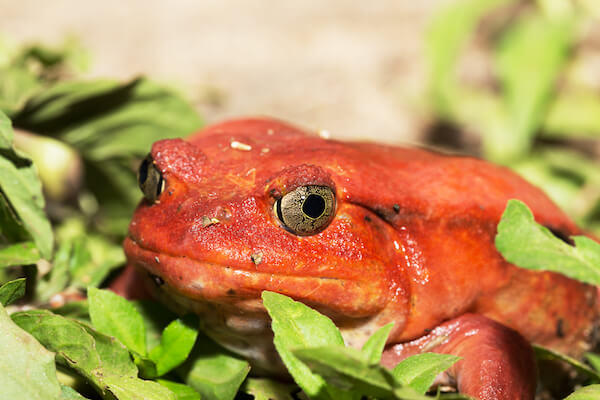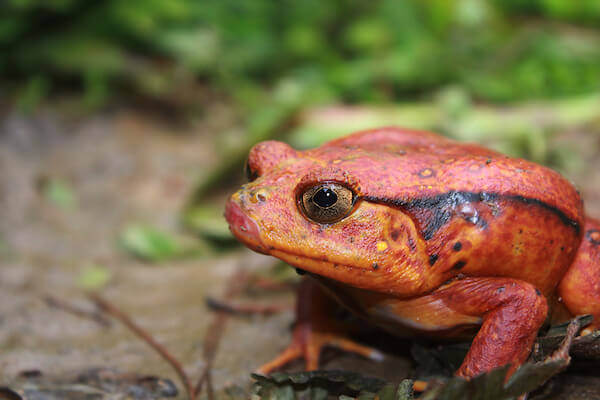What is a Tomato Frog?
Tomato frogs hail from various regions of Madagascar. Their scientific name is Dyscophus, which is the sole genus classified within the Dyscophinae subfamily.
Dyscophus antongiliiDyscophus guinetiDyscophus insularis
- Dyscophus antongilii (common name: tomato frog)
- Dyscophus guineti (common name: Sambava tomato frog)
- Dyscophus insularis (common name: Antsouhy tomato frog)
The tomato frog gets its common name from the color of its skin, which is a bright tomato red. When these frogs feel threatened or fearful, they will puff up their bodies to make themselves look bigger and, therefore, more intimidating to their opponents. The tomato frog has a defense mechanism that helps it escape attacks by predators in that when an opponent tries to grab the tomato frog by its mouth, the frog will secrete a toxic white substance. This can get into the eyes and mouth of the predator and cause it to drop the tomato frog. While this toxin can be harmful to humans if they’re allergic, it is not deadly to people.

As for its lifespan, the tomato frog lives anywhere from six to eight years in captivity. In the wild, they can live for over a decade. Breeding season occurs between February and March, which is after the heaviest rainfall occurs in Madagascar. The males will issue mating calls to the females during the night, as they are nocturnal creatures. It takes these frogs anywhere from about 9 to 14 months to reach sexual maturity, and females will lay anywhere from 1,000 to 1,500 eggs, which hatch within 36 hours of being laid upon the surface of the water. As tadpoles, tomato frogs prefer to eat the tiniest pieces of sustenance that they can find in and filter out from the water.
- Lifespan: 6 to 8 years
- Size: 6 to 10.5 cm
- Weight: 1.6 to 7.8 oz
- Sexual Maturity: 9 to 14 mos
- Eggs Laid: 1000 to 1500 eggs
- Self Defense: Puffs up & secrete toxins
Typically, the females are about three times the size of their male counterparts. Adult females can measure anywhere between 8.5 to 10.5 cm in length, while the males tend to be about 6 to 6.5 cm long. The average weight of the tomato frog can be anywhere from 1.6 to 7.8 oz, with the females generally outweighing the males. The females tend to have a more vibrant reddish-orange tint to their skin, whereas male tomato frogs have a more muted shade of yellowish-orange. Their undersides tend to be a whitish-yellow color, and some of these frogs will have little black spots on their throats. Their vibrant reddish-orange bodies indicate that they are not palatable to predatory creatures, such as snakes (who are their most common predators).
If you are looking to bring a tomato frog (or two) into your family, you should know that only Dyscophus guineti and Dyscophus insularis are legal to own in the United States. Dyscophus antongilii is an endangered species in Madagascar due to deforestation and being taken into captivity by too many humans. They are currently listed in Appendix I of the Convention on International Trade in Endangered Species (CITES). This means that this species of tomato frog is very close to becoming extinct. The other two species are not, hence why they can be sold in pet shops across the United States and elsewhere. These species tend to be most predominantly sold during the late spring to early summer after they have reached sexual maturity.
Setting Up an Environment Habitat
When setting up a living space for the tomato frog, you will need to consider the fact that these frogs are terrestrial, which means that they have adapted to being able to live on solid ground. They enjoy being able to safely and snugly burrow into muddy or sandy areas that are close to water sources.
If you plan on having only one or two of these frogs, a 10-gallon aquarium will suffice. However, these frogs love to explore and, therefore, benefit from having a larger terrarium to roam around in. Also, since they enjoy burrowing and hiding, investing in a few log tunnels for the terrarium can serve as a tomato frog’s favorite spot.
Instead of lining the terrarium with living plants (which tomato frogs tend to damage when they burrow), you might want to save some money by adding realistic plastic plants. They should also have plenty of soil in the bottom of the terrarium since they enjoy burrowing in the substrate. Before you lay any soil down, check the packaging to make sure that the soil is free from harmful pesticides, herbicides, or fertilizer. If you want a safe alternative, coconut fiber works just as well as soil.
As far as lighting goes, tomato frogs do not require the presence of a UV light, although some real plants will need a daylight spectrum bulb in order for them to properly grow and flourish. The terrarium’s temperature should ideally be set somewhere between 65 and 80 degrees Fahrenheit. Higher temperatures will kill tomato frogs, and you will need to keep an eye on temperatures during the winter if you let your home’s ambient temperature drop below 65 degrees. This is where investing in a heating pad to place beneath the terrarium can come in handy.
Since tomato frogs thrive in humid climates, the terrarium will need to be misted once every three days at a maximum. A ventilated glass lid is a great way to help keep the terrarium nice and humid.
Feeding Tomato Frogs

Tomato frogs are carnivorous, mainly sticking to small and easy-to-digest insects. They tend to prefer worms, tiny invertebrates, and insects that are along the lines of flies, mosquitos, and beetles. The tomato frog likes to ambush its prey, so it will patiently and covertly sit in wait until the unsuspecting prey arrives. When it does, the tomato frog will snatch it with its tongue, capturing and devouring its prey in a fraction of a second. Once they get their prey inside their mouths, tomato frogs (who are toothless) will mash their prey around and grind their food down before swallowing it.
A bowl of fresh, dechlorinated water should be present in the terrarium at all times. Tomato frogs love to sit in water, so the bowl should be big enough for your tomato frogs to sit in without the water coming up over their necks. In order to remove chloramines and chlorine from water that comes from a municipality, you will need to purchase an aquarium water conditioner from your local pet store or online.
When feeding a tomato frog, you will need to get them live nightcrawlers or small invertebrates (like crickets) and place them in the terrarium. Some nightcrawlers might be a bit too long for a tomato frog, so you will need to cut lengthy worms in half before feeding them to your frog.
Tomato frogs should ideally be fed about three to six crickets per frog several times each week. It is best to feed these frogs at night since they are nocturnal, but they will also eat during the day. If you are new to owning a tomato frog, you will need to spend some time monitoring their food intake at first. If you see several crickets still hopping around the terrarium two or three hours after feeding time, you are overfeeding your tomato frogs.
How to Keep a Frog Healthy
Since tomato frogs require calcium and other essential vitamins to keep them healthy, you will need to invest in calcium and vitamin supplements specifically manufactured for your frogs. A small dusting of calcium or vitamin powder once per week over their food is beneficial for adult tomato frogs. Since young tomato frogs are still physically developing, they will require several sprinklings of calcium or vitamin powder each week. Additionally, you can help improve your frog’s color and keep them healthy by giving them weekly doses of a carotenoid supplement. It has been found to benefit multiple species of frogs and even improves reproductive health in some species.
Before you even purchase a tomato frog, you should be aware that chemical residue on your skin that is leftover from bath and beauty products can be harmful, if not downright deadly, to tomato frogs. When you do have to handle these frogs, you need to thoroughly rinse your hands with warm water before and after handling them. Also, handling should be minimal since tomato frogs are not very fond of being handled. If your frog begins oozing a white substance onto your hands, this is a strong indicator that your frog is getting defensive and would prefer to be put back in the terrarium. If you get this substance onto your skin, gently put your tomato frog away and quickly go give your hands a thorough wash.
One last major health-related note is that tomato frogs do not do well when living with other types of frogs. In fact, tomato frogs are prone to predator-prey stress. Even if the other frog species is not predatory toward them, tomato frogs can become stressed out and defensive against these other frogs. They also don’t often do well with tomato frogs who are different in size or age. Additionally, some diseases can be transmitted between different frog species, so it is generally a good idea to only let the same species cohabitate together in a terrarium. Generally-speaking, tomato frogs thrive the best with other tomato frogs who are similar in size and age.

Reviewed By: Tim Winter

Tim Winter has a strong affection for pets and wildlife. His years of experience caring for various types of pets has led him to share his knowledge with others on the best practices in pet care. Tim holds a Bachelor of Science from the University of Oregon School of Journalism and Communications.
